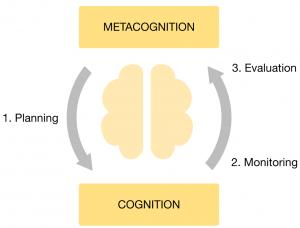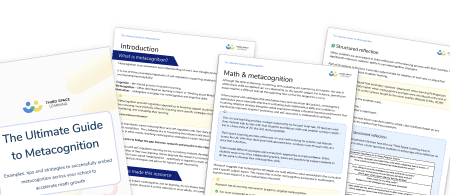Metacognitive Strategies: Using them at home
Here you will find all you need to know about metacognitive strategies, why you should care and how to use them at home. Referring to how children can monitor and direct their own learning, metacognition plays an important role in your child’s development.
Research shows that when you encourage the adoption of metacognitive strategies, your child is more likely to improve their attainment. For this reason, we are focusing on how you can encourage the use of such metacognitive strategies, helping them progress in their learning.
Sounds complicated? Don’t worry, we’ve got you covered.
The Ultimate Guide to Metacognition
Practical examples, tips and strategies to successfully embed metacognition across your school to accelerate math growth.
Download Free Now!Background to metacognitive strategies
When we approach any task, we bring knowledge about:
- our own ability
- what strategies are effective
- ideas regarding the particular type of activity
As we work through the activity, we adapt depending on how the task is going. The process we go through is summarized below:

Metacognitive strategies are all about acknowledging this planning, monitoring and evaluation. Children who recognize this cycle are characterized as ‘self-regulated’ learners. They are able to note when they are planning, monitoring and evaluating, questioning themselves when needed.
_________
‘Self-regulated learners are ‘learners who are proactive in their efforts to learn because they are aware of their strengths and limitations.’
Zimmerman, B J, 2010.
_________
Modeling metacognitive strategies
As an example, the below questions refer to the simple task of drawing with your child at home.
That said, the questions posed can be easily adapted to various activities.
The spirit encapsulated by the questions will help your child to benefit from the power of metacognition.
When completing the task, discuss with your child responses to the below questions:
Planning
- What is the goal of this task?
- Have I completed such a drawing before and how did it go?
- Where is the best place to start?
- Do I need extra resources to help me?
Monitoring
- How am I doing here?
- Is there anything I could change to help me reach the goal?
- What has gone well so far?
- How do I feel about this task?
- Do I need to take a break and come back to this later?
Evaluating
- How did it go?
- How would I do this differently next time?
- Did I reach the goal set at the start?
- Is there a technique I would use differently next time?
- Did I start in the right place?
Going forward, the goal is for your child to start asking these questions of themselves. Such a mindset will help them navigate the many tasks they will come across in life.
With practice, they will be able to plan, monitor and evaluate how they are getting on effectively, increasing the likelihood of success in reaching their goals.
Starting early
A common misconception is that these skills can only be developed in older children. However, research shows that children as young as three are able to engage in a wide range of metacognitive behaviors.
For example, they are able to set goals and check their understanding. This indicates that they are able to plan and monitor.
Of course, these skills become more robust as children grow. But don’t let young age prevent you from encouraging the use of metacognitive strategies as part of your home learning efforts.
We hope this gives you a good idea of how to start exploring metacognition with your child. We know how difficult it is to find the time to do such activities, but when you do – spare a thought for the above questions.
And if you’re looking for activities to do at home, try our list of free home learning resources.
Read more: Why You Should Be Using Sentence Stems
Do you have students who need extra support in math?
Give your students more opportunities to consolidate learning and practice skills through personalized math tutoring with their own dedicated online math tutor.
Each student receives differentiated instruction designed to close their individual learning gaps, and scaffolded learning ensures every student learns at the right pace. Lessons are aligned with your state’s standards and assessments, plus you’ll receive regular reports every step of the way.
Personalized one-on-one math tutoring programs are available for:
– 2nd grade tutoring
– 3rd grade tutoring
– 4th grade tutoring
– 5th grade tutoring
– 6th grade tutoring
– 7th grade tutoring
– 8th grade tutoring
Why not learn more about how it works?
The content in this article was originally written by primary school teacher Sophie Bartlett and has since been revised and adapted for US schools by elementary math teacher Christi Kulesza.





